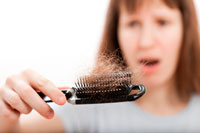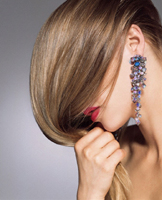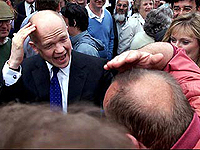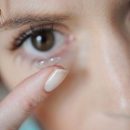What is total and universal baldness? Are these forms of the nest alopecia are cure? Answers to these questions you will learn from this article.
Content
Nest alopecia - autoimmune hair follicles.
The disease begins with a sudden appearance on the scalp of one or more small, round shape of the bald sections, which slowly increase in size, can reach the values of 5-10 cm in diameter. In cases of formation of several pits, they, increasing, can merge among themselves, forming large areas of full hair loss of large-ended outlines. The skin on the bald sections is usually normal painting and only sometimes, at the beginning of the development of the lesion, it seems slightly pink and swelling. The surface of its smooth, shiny, peeling is not marked.
In addition to the scalp, the nest alopecia may occur in the field of beard growth, on the pubis, eyebrows.
What is total and universal alopecia
 In some cases, the defeat, starting with the formation of individuals, can lead to full baldness of the scalp (total alopecia) or universal baldness, with a loss of not only long, but also powder hair on the head and body. Sometimes total baldness occurs acutely without passing the stage of the slope. It exists usually for many years and cures with great difficulty. Both with a nest and total alopecia, recurrences are often observed on cure.
In some cases, the defeat, starting with the formation of individuals, can lead to full baldness of the scalp (total alopecia) or universal baldness, with a loss of not only long, but also powder hair on the head and body. Sometimes total baldness occurs acutely without passing the stage of the slope. It exists usually for many years and cures with great difficulty. Both with a nest and total alopecia, recurrences are often observed on cure.
The disease can begin at any age, but more often is celebrated in young people (15-30 years). It is believed that approximately 1.7% of the population in their lives are faced with the nest alopecia.
Genetic predisposition is an important factor in the pathogenesis of the nest alopecia. Family history of the disease is observed in 10-20% of patients. The factors of the external environment, predisposing the disease, are infections, medicines, injuries, stress, in many cases they remain unclear.
If patients with a small amount of small sections of the nest alopecia are possible spontaneous remissions (in 80% of patients for 1 year), then remission for total and universal alopecia is marked only in 10% of patients.
According to the testimony, consultation of the psychotherapist, endocrinologist, neuropathologist.
The therapy of premature alopecia is most often consigned to intensive tall treatment. It cannot lead to the restoration of the hairproof, but it is capable of significantly reduce the progression of the process.
Currently developed methods of operational treatment of alopecia. For example, hair transplantation on the skin in the bald sections, as well as a sebum transplant (scalp) along with hair. These operations are expensive and are performed in specialized clinics.
With the nest alopecia, the treatment is carried out outpatient or in a dermatological hospital (with an extensive process and stubborn flow). Vitamins A, E, C, N, Nicotinic, Pantothenic and Folic Acid are used; Preparations of Fourocumarine (Beroxane, Psoralen, Ammifurin, Meladinin); sedatives; Hormones ACTG and glucocorticoids. The latter are also used externally in the form of ointments. Locally used retaental paste, alcoholic and essential solutions with the addition of sulfur, salicylic acid, trim pepper tincture; Ammifurine and melamidine are also used, followed by uve-rays or photochemotherapy (PuU-therapy). From physiotherapy means, darsonialization, cryotherapy in snow of coalic acid, cryoissage and massage with electric power.
Baldness - are a multifactorial disease. That's why not
some one universal treatment of baldness and it
It is unlikely to ever found. The treatment method is chosen depending on the localization and prevalence of foci, the degree of activity of the pathological process.









